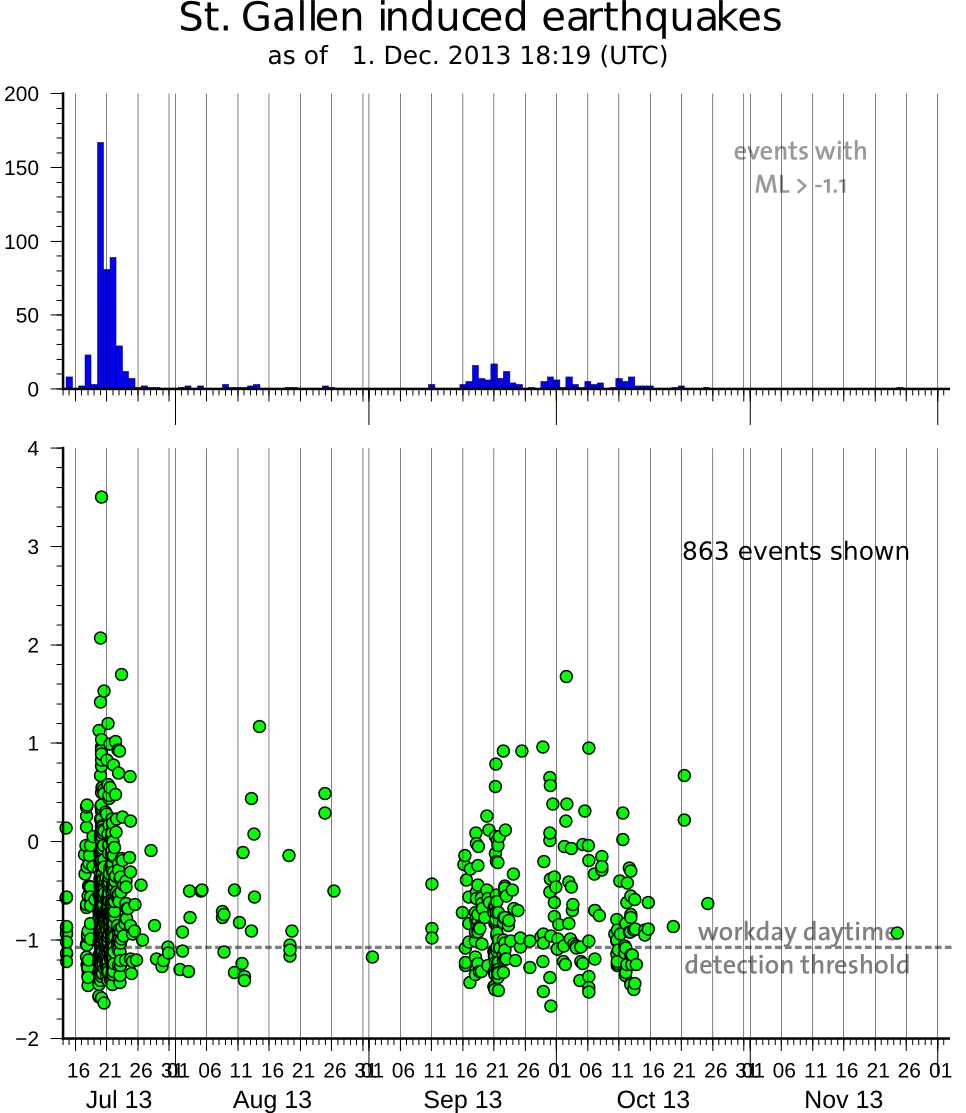News Archive 2014
2014-12-19
Earthquake near Yvonand (VD)
In the canton of Vaud, near Yvonand, the Swiss Seismological Service registered an earthquake on December 18, 2014 at 00:04:26 (local time). The event had a magnitude of 3.0 and occurred at a depth of 28.8 km. Although the earthquake could be felt over a wide area no damage is expected.
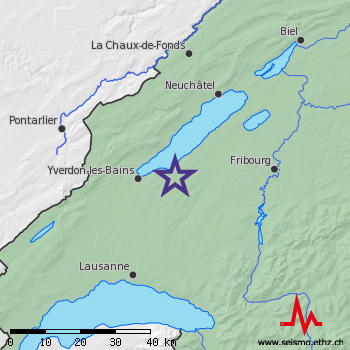
2014-12-15
Erdbeben bei Weinfelden
Der Schweizerische Erdbebendienst an der ETH Zürich hat im Kanton Thurgau in der Umgebung von Weinfelden ein Erdbeben registriert. Das Beben mit einer Magnitude von 3.2 ereignete sich am 15. Dezember 2014 um 07:58:17 Uhr (Lokalzeit) in einer Tiefe von 22.6 km. Aufgrund der grossen Herdtiefe wurde das Erdbeben nur vereinzelt verspürt. Schäden sind keine zu erwarten.
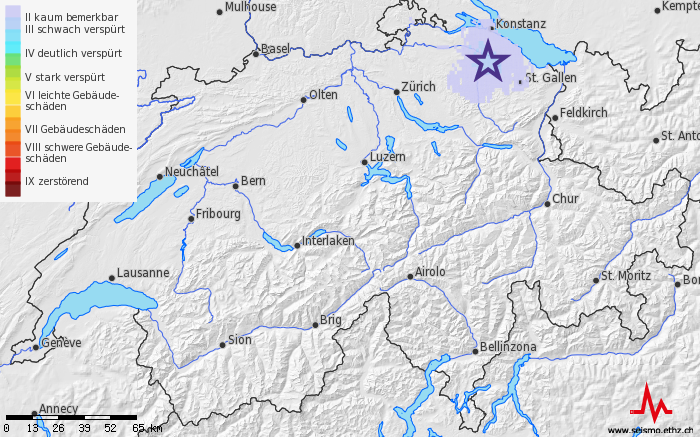
2014-12-07
Erneutes Erdbeben bei Wildhaus
Am 07. Dezember 2014 um 08:26 Uhr hat sich bei Wildhaus (SG) erneut ein leichtes Beben mit einer Magnitude von 2.7 in einer Tiefe von ca. 3 km ereignet. Bei einem Erdbeben dieser Stärke ist mit keinen Schäden zu rechnen. Am 04. Dezember ereignete sich in derselben Region bereits ein Erdbeben mit einer Magnitude von 2.4.
Eine solche Sequenz stellt nichts Ungewöhnliches dar. Über den zukünftigen Verlauf von Erdbeben lassen sich aber generell keine verlässlichen Aussagen machen. Meist enden solche Häufungen nach einigen Wochen, in seltenen Fällen kommt es zu grösseren Ereignissen.
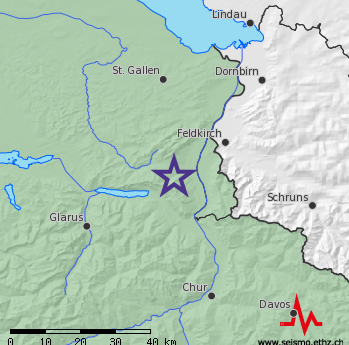
2014-12-01
The Somewhat Different Advent Calendar – The Jubilee Year in 24 Days
Before the Swiss Seismological Service quietly celebrates its 101st birthday, Snapshot 12 reviews the highlights of the jubilee year. Until December 24, a door opens every day to reveal selected events and highlights of the last 12 months.
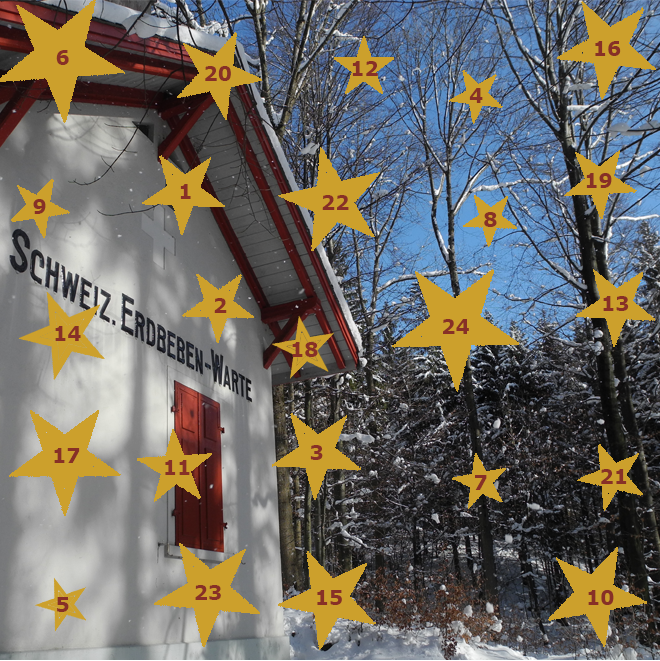
2014-11-24
Earthquake near Vallorcine (F)
On Sunday night, November 23, 2014 at 9:52 pm (local time), an earthquake occurred near Vallorcine close to Chamonix (France) with a magnitude of 3.2 and a depth of around 5 km. The earthquake was widely felt in the Rhône Valley between Fully and Aigle. Around 300 people reported the earthquake on our website. In France the earthquake was felt as far as Bonneville and Albertville according to the Bureau Central Sismologique Français (franceseisme.fr). For an earthquake of this magnitude no damage is expected.
The earthquake is part of a series of earthquakes, which occurs on a fault close to Vallorcine. This sequence is particularly active since the occurrence of an earthquake with a magnitude 4.9 in the year 2005. The largest subsequent earthquake occurred in 2012 with a magnitude of 3.6.
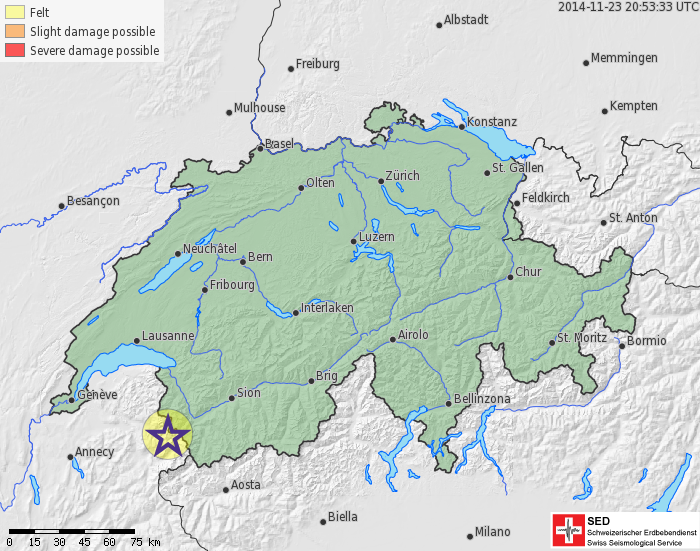
2014-11-20
Energy from the Earth’s Interior
The increased use of renewable energies is a central pillar of Swiss energy policy. A new study by TA-Swiss carried out in conjunction with the Swiss Seismological Service illuminates the opportunities and risks of deep geothermal projects as a possible alternative to fossil energy carriers and nuclear energy.
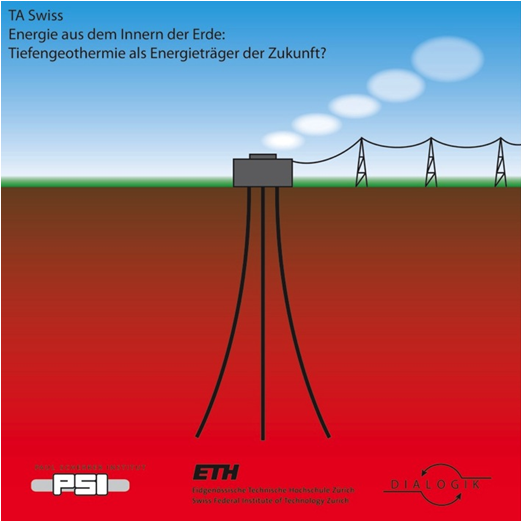
2014-11-18
Earthquakes in the lecture theater
Fortunately, earthquakes rarely occur in lecture theater. In a short video, our seismologists explain which subjects made them tremble and what their day-to-day professional life looks like. Using typical exam questions and photos of excursions, we also provide insights into studying Earth Sciences at ETH Zurich. In various profiles, we discuss what other activities are in demand at the SED and what requirements they have.
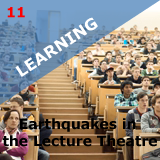
2014-11-14
Earthquake near Walenstadt
On Friday morning, November 14, 2014 at 05:14, an earthquake occurred near Walenstadt (SG). With a magnitude of 3.1 and a shallow depth, the earthquake was strong enough to be felt in the region of lake Walensee. For an earthquake of this magnitude no damage is expected.
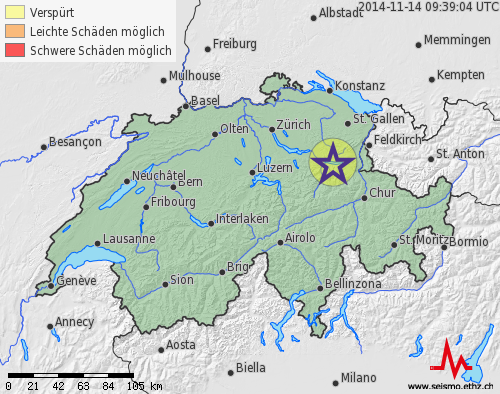
2014-11-08
Earthquake near Volketswil
On Saturday, November 8, 2014 at 17:04, an earthquake occurred north to Volkestwil (ZH). With a magnitude of 2.8 and a depth of 11.4 km, the earthquake was strong enough to be felt by a few people in region between Zurich and Winterthur. In case of earthquakes of this magnitude, no damage is expected.
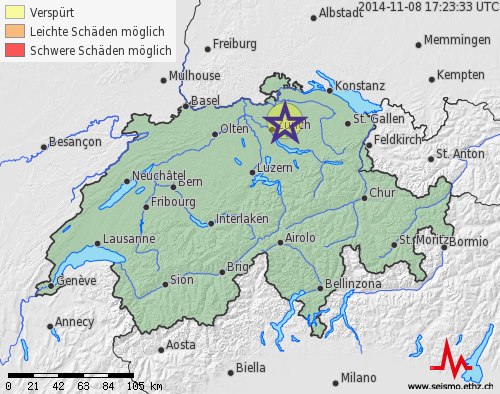
2014-09-10
Welcome to the Jubilee Exhibition
Since September 6, 2014, the jubilee exhibition unforeSeeable – Earthquakes in Switzerland has been welcoming guests keen to visit the land of earthquakes, Switzerland. In the course of Zurich’s Long Night of Museums, over 2,000 visitors embarked on this voyage of discovery, exploring the latest findings from earthquake research and attempting to construct more or less earthquake-resistant houses.
Read more...Click through the image gallery for an impression of how the exhibition was brought to life and for pictures of the opening. The exhibition is open until November 30, 2014.
Over the past few months, seismologists, historians, graphic designers, architects, IT specialists, cartographers, and many others have devoted their time and energies to the unforeSeeable – Earthquakes in Switzerland exhibition, collecting, selecting, wording, and then finally editing material for the displays. The concept and design were developed in parallel to ensure the exhibition would be a memorable experience. In addition, a huge milling machine was deployed to produce a relief of Switzerland, accurate down to the last millimeter, which now displays colorful earthquake maps in all variations. In the end, staff had just three days from the tightening of the first screw until the opening of the exhibition.
On Sunday, September 21, 2014, all are invited to attend an Open House, the perfect opportunity for you to get to know the Swiss Seismological Service up close.
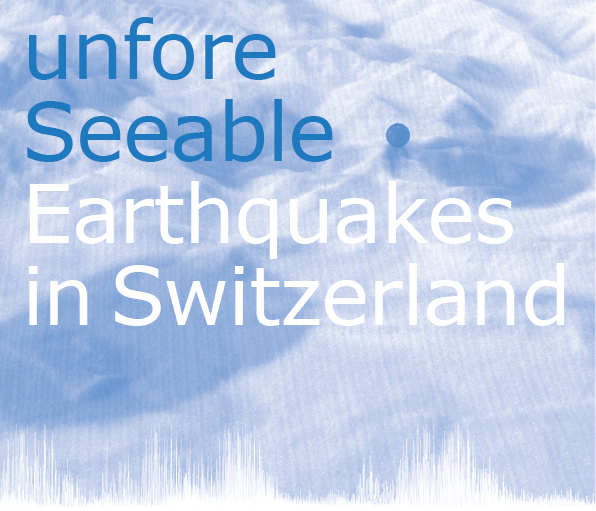
2014-10-15
Again Noticeable Earthquake Near Diemtigen
On October 15, 2014, at 9.36 p.m., an earthquake with a magnitude of 3.2 occurred once again near Diemtigen (BE) at a depth of some 9 kilometers. This was the third noticeable earthquake in this region in 2014. There were earlier noticeable earthquakes on June 25, 2014, with a magnitude of 2.6 and on May 10, 2014, with a magnitude of 2.7.
The October 15 earthquake was felt over an extensive area, but damage is generally not expected to occur when there are earthquakes of this magnitude. In addition to the shaking, many people also noticed a bang. Noises like these occur when the earthquake waves strike the surface of the earth and are a frequent accompaniment of earthquakes.
Read more...The earthquake is part of a series of earthquakes in this region that started on April 13, 2014. In the meantime, the Swiss Seismological Service (SED) has registered more than 150 quakes with magnitudes of between 0.5 and 3.2. In the past two months, earthquake activity continually subsided until last week, when the measuring instruments again recorded a new rise in activity. To study the sequence in more detail, the SED set up three temporary measuring stations in this area in July.
In so-called earthquake swarms numerous earthquakes occur over a longer period without a clear sequence of preliminary quakes, main quakes, and aftershocks. Earthquake swarms are not unusual throughout the world, as well as in Switzerland. This swarm activity usually ends after a few weeks or months; in rare cases, the strength and number of the earthquakes increase over time. The development of an earthquake swarm is just as hard to predict as earthquakes in general.
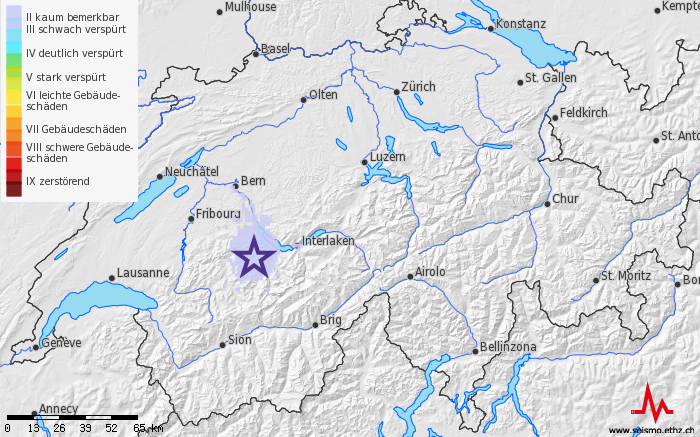
2014-10-15
Communicating during and Away from an Incident
It is the middle of the night, and suddenly your bed is shaking and your glasses are rattling in the cupboard – and you wonder whether dreams can really seem so real. At the Swiss Seismological Service, we try to find an answer to such questions and immediately inform you if a noticeable earthquake has disrupted your dreams.
Snapshot 10 shows you what, how, and with which channels the SED communicates during and away from an incident.
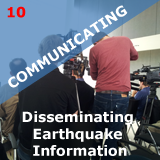
2014-09-17
Earthquakes on Mars
When the ground shakes beneath our feet, we are experiencing earthquakes. Through scientific measurement and investigation of these motions, we now basically understand the earthquake process and the structure of the Earth. Each subsequent earthquake we measure provides additional information that allows us to improve our picture of the Earth’s internal structure.
We expect similar seismic processes occur on other rocky bodies in our solar system, including Mars. Snapshot 09 introduces the "InSight" mission, with the objective to explore the interior of Mars. The key component of this project is a sensitive seismometer that will be placed on the planet in order to record ‘marsquakes’ for the first time.
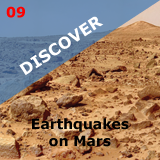
2014-09-22
Open House
Over 600 adults and children braved our earthquake shake-table, admired seismometers, triggered min-earthquakes, and discussed earthquakes with staff at the our 'Open Door’ on 21 September. We at the SED thank all our visitors!
Some memories of the day are on our photo gallery.
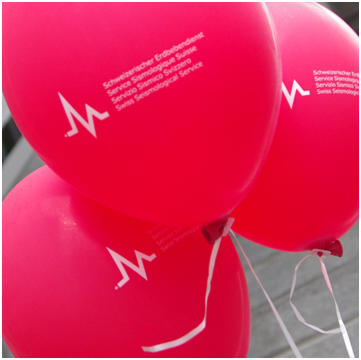
2014-09-10
"cogito Prize 2014" for the Reassessment of the Basel Earthquake of 1356
Every two years, the cogito foundation awards a prize of CHF 50,000 to researchers who are engaged in successful, interdisciplinary projects. This year, the cogito Prize is being awarded to Donat Fäh, a professor at the Swiss Seismological Service (SED). Together with a team of historians, archaeologists, civil engineers, seismologists, and geologists, he reassessed the Basel earthquake of 1356. The research was performed in the context of the local seismic hazard analysis for the Basel region, the results of which were then converted into a microzonation.
At the public award ceremony on September 26, 2014, Donat Fäh presented his award-winning project Die Erdbebenkatastrophe 1356 in Basel – eine Beurteilung im Kontext der regionalen seismischen Gefährdung (The 1356 Basel Earthquake Catastrophe – An Assessment in the Context of the Regional Seismic Hazard).
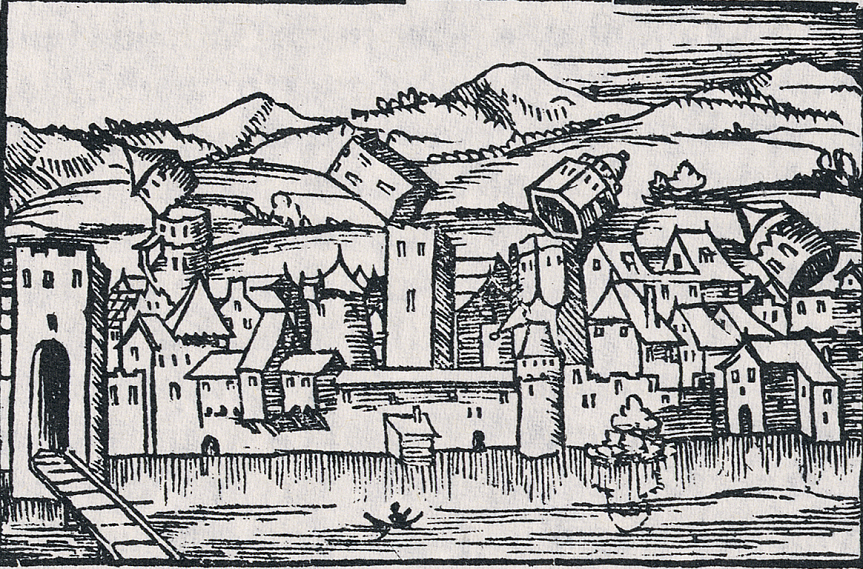
2014-09-01
unforeSeeable – Earthquakes in Switzerland
September 6 to November 30, 2014, focusTerra museum
At the present time, earthquakes cannot be predicted. Nevertheless, a lot is known about where, why, and how often they occur. To make these aspects visible, the Swiss Seismological Service will present an extensive exhibition on the occasion of its 100th anniversary.

2014-08-28
Earthquake near Lake Garda
On Thurday, August 28, 2014 at 7:49 p.m., an earthquake occurred near Lake Garda (IT). With a magnitude of 4.1, it was strong enough to be felt by few people in the valley of Poschiavo and in Ticino. In case of earthquakes of this magnitude, minor damage in the epicentral area is possible.
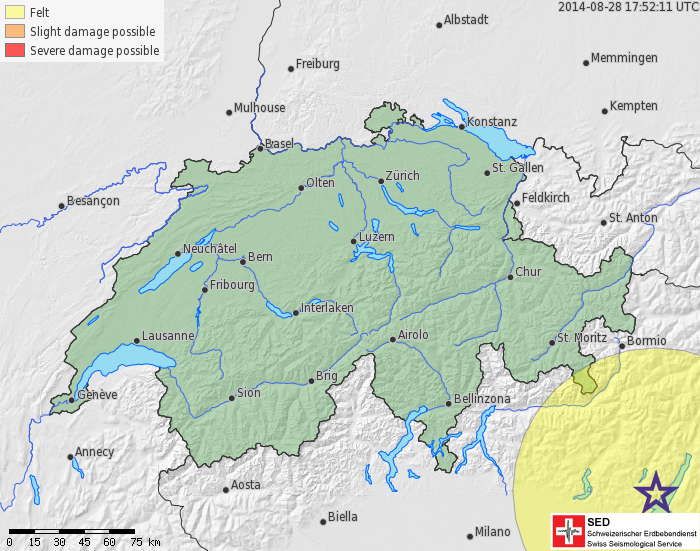
2014-08-20
"Erdbebenüberwachung bleibt eine Herausforderung"
In der Sendung Kontext auf SRF 2 gewährt Stefan Wiemer im Interview mit Anita Vonmont Einblicke in das Erdbebenland Schweiz und seine persönliche Erdbebengeschichte. Neben natürlichen Beben sind auch menschgemachte Erschütterungen sowie künftige Entwicklungen in der Erdbebenforschung ein Thema.

2014-08-19
Earthquakes in the Data Mountain
The phrase “more seismometers, more earthquakes, and more data” clearly shows why the Swiss Seismological Service alone produces two to three terabytes of data every year containing information about recorded earthquakes. But why do we need this mountain of data? It is used to calculate specific patterns that allow us to draw conclusions about the size distribution and geographical distribution of earthquakes. This information, in turn, serves as the basis for risk analysis and research into the exact causes and mechanisms of earthquakes. Snapshot 08 provides insights into research results that come from the growing mountain of data.
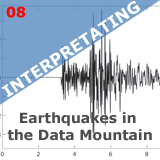
2014-07-18
Help, the Earth Is Shaking!
Do you know what you would do if the earth in Switzerland were to shake violently? In the large-format busy picture of Snapshot 07, you can find out the best way to behave before, during, and after an earthquake. You will also learn how the Swiss Seismological Service proceeds in an emergency situation.
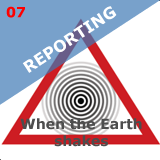
2014-07-08
Can You Spot the Difference?
To mark our 100-year anniversary, the logo of the Swiss Seismological Service has been given a new look. The seismogram remains at the heart of the logo, but has now been made more prominent, without taking anything away from the link to Switzerland. Further changes in the area of design are being worked on and will be incorporated into our products on a continual basis.

2014-07-04
Federal Authorities’ Natural Hazards Portal
Information about the current natural hazard situation in Switzerland can now be obtained at a glance from an easy-to-read map on the new web portal www.natural-hazards.ch. The federal agencies responsible for natural hazards were commissioned by the Federal Council to develop the joint web portal, which marks a further advance in the improvement of natural hazard warnings in Switzerland. The natural hazards web portal provides an overview of current hazard situations and warnings in relation to rain, snow, wind, storms, heat waves, frost, icy roads, floods, forest fires, avalanches and earthquakes.
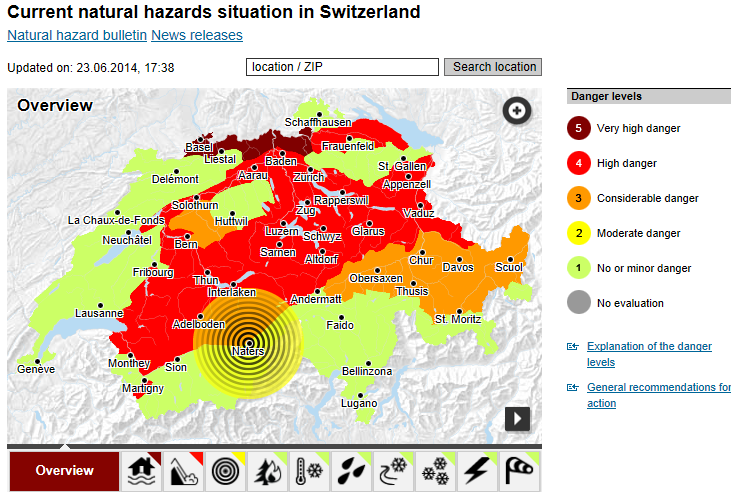
2014-06-25
Lightly felt earthquake near Diemtigen
On June 25, 2014, at 11.33 a.m., an earthquake with a magnitude of 2.6 occurred near Diemtigen (BE) at a depth of 9 kilometers. The light earthquake was noticeable in the Niedersimmental area and the Thun / Spiez region; damage is not expected.
The tremor is part of a series of earthquakes in this region that started on April 13, 2014. During this series, the Swiss Seismological Service (SED) has registered 97 earthquakes with magnitudes between 0.6 and 2.7. The strongest event so far had a magnitude of 2.7 and occurred on May 10, 2014 (for further information, please refer to the related news article below). To study the sequence in more detail, the SED has set up three temporary stations in this area.
Read more...In so-called earthquake swarms numerous events occur over an extended period of time without a clear succession of foreshock, mainshock, aftershock. Earthquake swarms are well-known phenomena globally and also in Switzerland. Usually this swarm-activity terminates after a few weeks or months, in rare cases the earthquakes become stronger and more frequent with time. The development of an earthquake swarm is equally unpredictable as the occurrence of earthquakes in general.
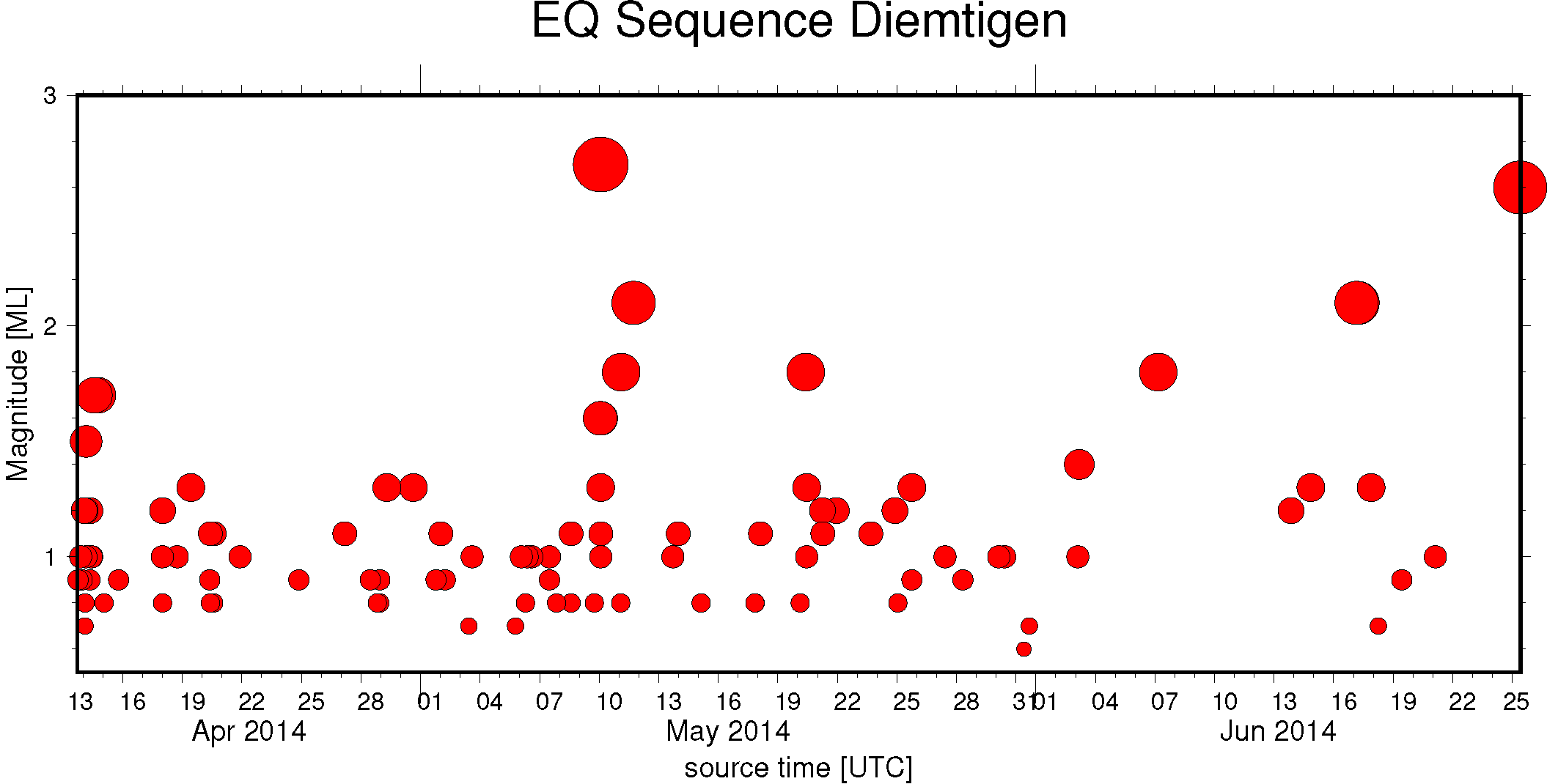
2014-06-19
Measuring earthquakes: An easy thing to do?
We feel, hear or read about earthquakes in Switzerland on average ten times a year. However, the large majority of earthquakes that the Swiss Seismological Service locates are not noticed by the population. These lie under the limit of human sensing and can therefore be only detected by sensitive measuring stations.
What are these instruments, where are they and what does it all take to build and operate a station is explained in Snapshot 06.
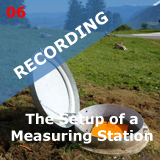
2014-06-06
Megaquakes may hit Bhutan
Since more than a year a temporary seismological network is operated in Bhutan by the Swiss Seismological Service, in collaboration with the Seismology and Geodynamics Group of ETH Zürich and the support of local authorities.
Read more...Results stemming from the first paleoseismological investigation in the country, carried out in collaboration with French colleagues in Montpellier, now show that Bhutan does not constitute a seismic gap (or zone of relatively lower activity), which overwrites the current knowledge. The evidence comes from river deposits that point to two major earthquakes of magnitude 8 or larger in the past 1000 years. New seismological data provided by the network will allow to link past and current seismicity and to accurately estimate earthquake hazard in the Eastern Himalayas.
Read the interview with György Hetényi, leader of Project GANSSER, in the ETH News here
More information on Project GANSSER in Bhutan can be found here
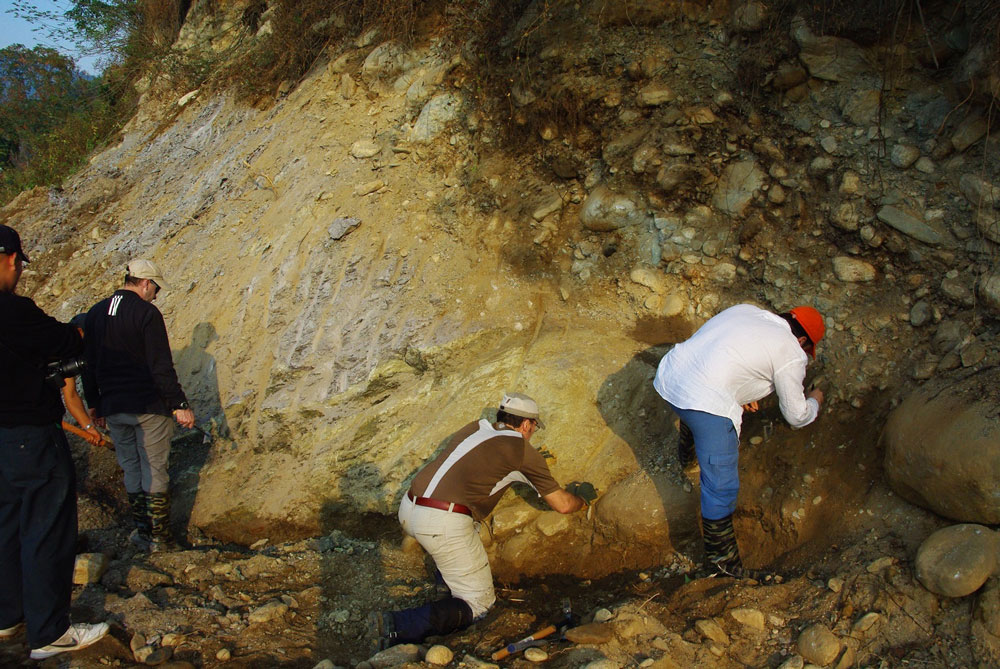
2014-05-26
Earthquakes in the Alps
Did you know that a look into the deep structure of the Alps reveals a lot about the distribution of earthquakes in Switzerland? Snapshot 05 explains why there are an average of two earthquakes per day in Switzerland and what role the formation of the Alps plays in this context. It lends some insight into the geological history of the Alps and reports on the largest historical earthquakes in the Alpine region. Seismic tomography illuminating the deep structure of the Alpine orogen provides the opportunity to understand the tectonic forces that shape mountains and cause earthquakes.
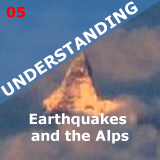
2014-05-10
Small Earthquakes near Diemtigen BE
In the early morning of 10. Mai 2014, at 3:45 a.m., a small earthquake of Magnitude 2.7 rattled the Niedersimmental and the region Thun / Spiez. The earthquake occurred at approximately 10 km depth near Diemtigen (BE), and was lightly felt within a radius of around 15 km.
This event is the strongest so far of a swarm of small earthquakes that commenced on 13. April of this year. Shortly before and after this earthquake another four microearthquakes occurred with magnitudes between 1 and 1.7. In total the SED registered around 60 events since the beginning of that swarm, all of them within an area of a few km and at a depth near 10 km.
Read more...In so-called earthquake swarms numerous events occur over an extended period of time without a clear succession of foreshock, mainshock, aftershock. Earthquake swarms are well-known phenomena globally and also in Switzerland. Between 16 and 18 April, for example, a sequence of more than 30 small events occurred near Frauenfeld (TG).
Usually this swarm-activity terminates after a few weeks or months, in rare cases the earthquakes become stronger and more frequent with time. The development of an earthquake swarm is equally unpredictable as the occurrence of earthquakes in general.
In Switzerland, earthquakes that are strong enough to cause damage can in principle happen anywhere anytime. On average, however, an earthquake of magnitude 6 or more happens only once in 50 to 150 years. The annual probability of such an earthquake in Switzerland is thus approximately 1 percent.
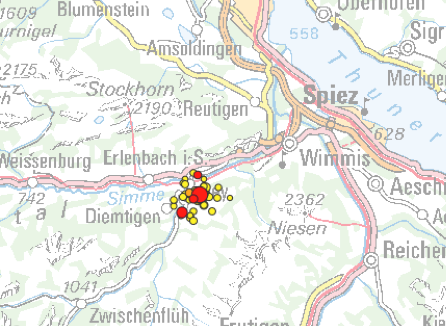
2014-04-10
Earthquakes in Art: Look, Listen,and Immerse Yourself
In Snapshot 04, we present earthquakes – but not using seismograms, magnitudes, or geological analyses.
We do not want to give away too much at this point – so look and listen for yourself how earthquakes are portrayed on canvases, for example, or are transformed into rhythms.
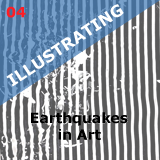
2014-04-10
Seismology@School Teachers Workshop
In Sion (VS) a Seismology@School workshop for teachers will take place from October 20 to October 24, 2014. This is the third such workshop in the framework of the EU project NERA. It addresses secondary school teachers who are currently teaching science or geosciences or are planning to do this in the future. The seminar will provide detailed information about earthquake sciences, new inspirations for your classes and the possibility to debate with peers.
Further information and the registration form can be found here

2014-04-08
Das grösste Erdbeben in den westlichen Alpen seit 50 Jahren
Am Montag, 7. April 2014 ereignete sich im Ubaye Massif in den französischen Alpen (auf unserer Webseite der Provinz Cuneo zugeordnet) um 21.27 Uhr ein Erdbeben der Stärke 5. Die Tiefe betrug 9 km.
Aus dem Epizentralgebiet (St. Paul sur Ubaye, Jausiers, Barcelonnette) liegen Berichte über abgestürzte Schornsteine sowie Risse in Gebäuden vor. In der Schweiz wurde das Beben bis in den 200 km entfernten Kanton Genf verspürt. Vereinzelt trafen auch Meldungen aus den Kantonen Waadt und Wallis ein. Beim Erdbebendienst gingen rund 150 Verspürtmeldungen ein.
Read more...Beim Beben vom 7. April handelt es sich um das stärkste seismische Ereignis im westlichen Teil der Alpen seit jenem von Corrençon (Vercors) im Jahr 1962. Es weist eine grössere Magnitude auf als die Beben von Epagny-Annecy (1996) und Vallorcine (2005), die ebenfalls in der Schweiz spürbar waren. Das Beben von Epagny verursachte aber aufgrund seiner Nähe zu bewohnten Gebieten grössere Schäden.
Die betroffene Region ist die seismisch aktivste der westlichen Alpen. Im Jahr 1959 ereignete sich ein Erdbeben mit einer Magnitude von 5.5 (St. Paul sur Ubaye, 5. April). Am häufigsten treten in diesem Gebiet jedoch sogenannte Erdbebenschwärme auf. Dabei handelt es sich um eine Vielzahl ähnlich grosser Beben, die sich nahe beieinander ereignen, ohne dass es zu einem Hauptbeben kommt. Zwischen 2003 und 2004 wurden beispielsweise 16‘000 Ereignisse lokalisiert (grösste Magnitude 2.7). Das Beben vom 7. April gehört zu einem weiteren Erdbebenschwarm, der 2012 begann. Es ereignete sich beinahe am selben Ort wie ein Erdbeben der Magnitude 4.3 am 26.02.2012.
Weitere Informationen zum Ereignis bei Ubaye finden Sie bei Sismalp.
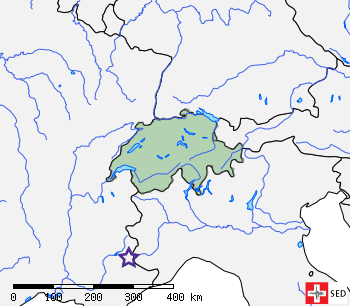
2014-03-25
Le Service Sismologique sur la RTS
Notre sismologue Clotaire Michel a donné une interview en direct dans l'émission scientifique CQFD de La Première dans le cadre des 100 ans du Service Sismologique. Il revient sur la sismicité de la Suisse et les réseaux de stations que le SED exploite avec un reportage à l'observatoire de Neuchâtel. Il y est aussi question des cartes d'aléa produites par le SED, des normes parasismiques en Suisse, des effets de site et la notion de risque. Finalement la problématique des séismes induits est aussi résumée.

2014-03-14
Man-Made Earthquakes
Thousands of minor and major earthquakes shake the world every day. Some of them are not the result of natural causes – they are man-made. Simply jumping up and down is not enough to cause them. However, technological activity in the subsoil, such as involved in mining and geothermal energy projects or in the extraction of natural gas, can cause earthquakes.
In Snapshot 03, you can use interactive graphics to explore how induced earthquakes occur and which natural forces – other than tectonic ones – trigger earthquakes.
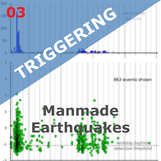
2014-03-12
Man-made earthquakes. A curse or a blessing?
On the 12th March, 2014, Stefan Wiemer held his inaugural lecture as chaired professor of the ETH Zurich. The theme of the lecture was induced seismicity. He highlighted the fact that earthquakes not only wreak havoc, but may also be useful in small doses.

2014-03-07
Ten New Weak Motion Stations in Northern Switzerland
The Swiss Seismological Service has extended its seismic network in Northern Switzerland. The 10 new monitoring stations will densify the national broadband network (SDSNet) and augment the station network in the region, which has been operated in collaboration with the National Cooperative for the Disposal of Radioactive Waste (Nagra) since 2003.
Read more...The aim of the extended monitoring network is to record seismic activity in the vicinity of the sites proposed by the Deep Geological Repository sectoral plan for the storage of high-level radioactive waste. The data collected will help to detect any potential, previously unknown active fault zones. The extended database will provide the responsible authorities with a basis for further studies.
Fact sheet with background information on the extended weak motion network in Northern Switzerland (only available in German).
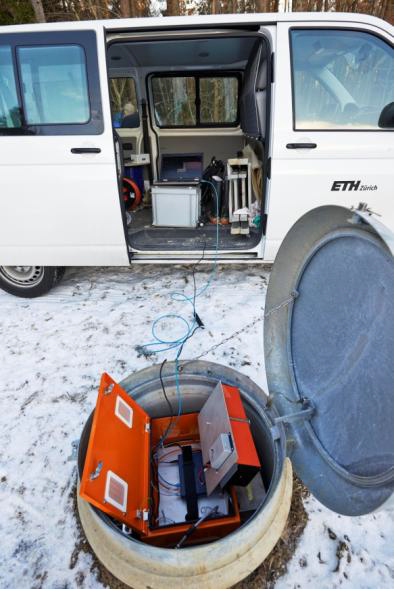
2014-02-14
Icequakes: What Seismic Measuring Devices Can Do
The Swiss Seismological Service (SED) uses its measuring devices primarily to record earthquakes in Switzerland and neighboring areas. But this is not all. Seismometers are also used to record a wide range of other geophysical phenomena, both on a national and international level.
Read more...One of the phenomena researched by the SED is ice and glacier quakes. In the second snapshot, you will find answers to questions such as: What can seismometers reveal about glaciers? Where is the SED currently carrying out measurements? What are the aims behind studying glacier quakes?
In addition to icequakes and earthquakes of natural origin, the highly sensitive seismic measuring devices also record man-made signals. We will show you which signals using a small overview.
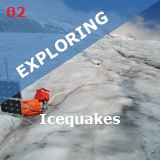
2014-02-03
"Erdbeben in der Schweiz – eine unterschätzte Gefahr"
Das Schweizer Fernsehen beleuchtete in einem Tagesschaubeitrag die Gefahr von Erdbeben in der Schweiz und die Rolle des Schweizerischen Erdbebendienstes anlässlich seines 100-jährigen Jubiläums.
Tagesschaubeitrag vom 1. Februar 2014 zum Thema "Schweizer Erdbeben werden unterschätzt"
Weitere Videos und Hintergrundinformationen zum Tagesschaubeitrag des SRF
"Die Schweiz unterschätzt die Gefahr von Erdbeben" SRF Interview mit Stefan Wiemer
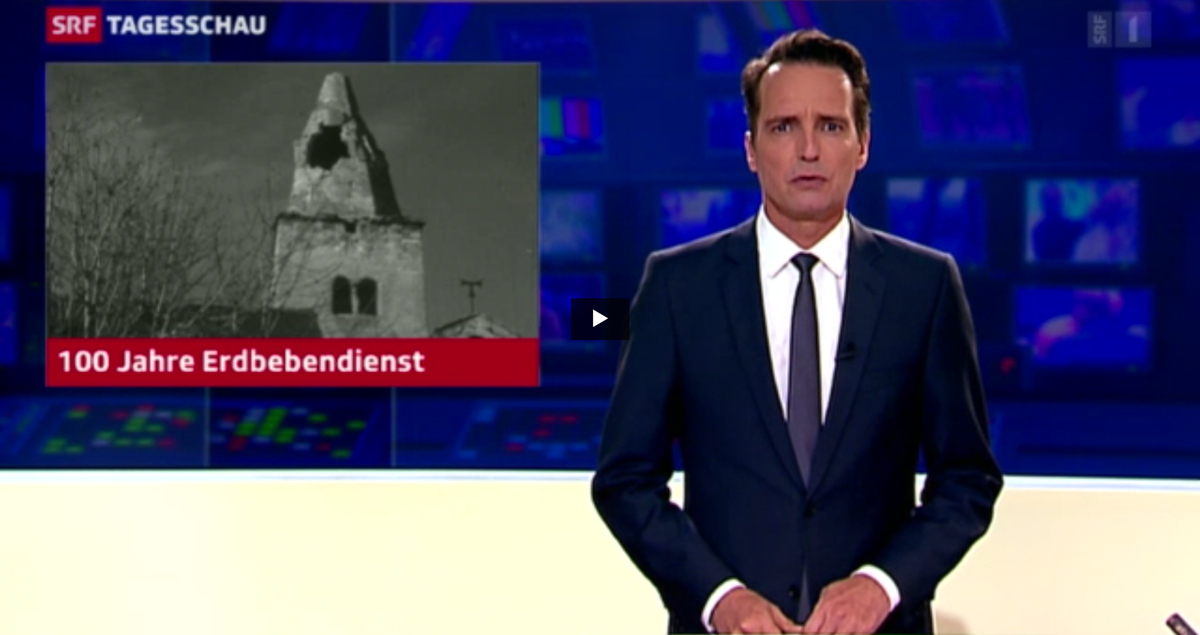
2014-01-27
Swiss Earthquakes in 2013: A Review
In 2013, the Swiss Seismological Service registered and localized around 600 earthquakes in Switzerland and its neighboring countries. Additionally, local seismic networks in the St. Gallen and Sargans regions detected nearly 300 microearthquakes over the same period. The magnitude of the earthquakes recorded in 2013 ranged between –0.6 and 4.1 on the Richter magnitude scale. Compared to the two previous years, this represents a slight increase in earthquake activity. The number of eathquakes with a magnitude of 2.5 or greater was 21, which is close to the average of 23 events per year over the past 38 years.
Read more...Three earthquakes were clearly felt by the population in 2013: the earthquake near St. Gallen on July 20 (magnitude of 3.5) and the two earthquakes near Sargans on December 12 and 27 (magnitudes of 4.1 and 3.7). The St. Gallen earthquake was part of a sequence of over 300 localized events between July and November that are linked to test and simulation activities carried out as part of the planned geothermal energy project. The earthquake with a magnitude of 4.1 on December 12 near Sargans was followed by a series of over 30 aftershocks that were sustained into the second half of January 2014.
Generally speaking, the earthquakes in 2013 were concentrated in Valais and the canton of Graubünden, not unlike past years. There were also more earthquakes in Central Switzerland, the canton of Fribourg, and along the Jura than in the rest of Switzerland.
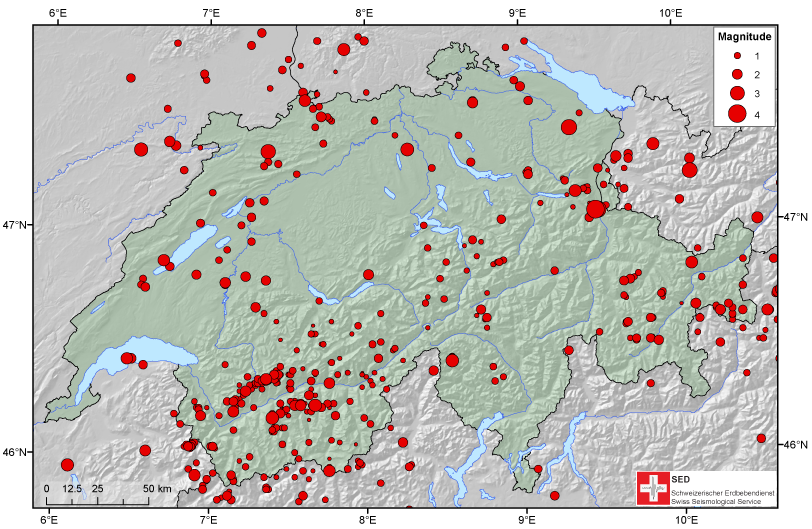
2014-01-09
Zwei Erdbeben nahe Biel
Am Abend des 8. Januar 2014 ereigneten sich kurz aufeinander um 19.12 Uhr sowie um 19.27 Uhr (Lokalzeit) zwei Erdbeben mit Magnituden von 2.7 und 3.2. Das Hypozentrum beider Beben lag mit einer Tiefe von ungefähr 10 km relativ nahe der Erdoberfläche. Die Beben wurden von der Bevölkerung deutlich wahrgenommen. Beim Erdbebendienst gingen zahlreiche Verspürtmeldungen aus dem Berner Jura sowie aus der Region Biel ein.
Read more...Obwohl es ziemlich selten vorkommt, dass zwei Erdbeben in einem so kurzen Zeitabstand auftreten, erlaubt dies keine Schlüsse über den möglichen Fortgang der Sequenz. In der Nacht auf den 9. Januar 2014 kam es zu 5 Nachbeben mit Magnituden von ungefähr 2. Bei Beben dieser Stärke werden keine Schäden erwartet.
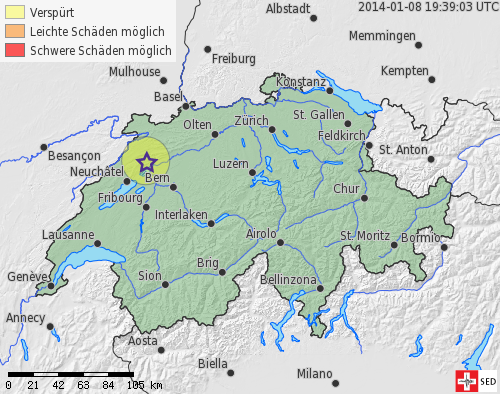
2014-01-09
Nearly 13'100 Earthquakes in 100 Years
Since its establishment 100 years ago, the Swiss Seismological Service has recorded around 13,100 local quakes. With the anchoring of earthquake monitoring in a federal act in 1914, the Swiss Seismological Service became the official federal agency for earthquake monitoring. The Swiss Confederation thus transformed what had previously been a voluntary activity into an institution that is attached to ETH Zurich today.
Of the 13,082 earthquakes recorded, 1,600 could be felt by people. The tasks and activities undertaken by the Swiss Seismological Service over this period are almost as numerous. As part of our jubilee year, we are delighted to take you on a voyage of discovery and give you insights into the past, present, and future aspects of the Swiss Seismological Service.
In the Snapshots section on our website, we publish unusual insights into our work throughout the year. Find out how earthquakes are seen, heard, measured, or made. We are delighted to invite you in to our open house when we will also officially launch our jubilee exhibition that will welcome visitors up to the end of November 2014. Short lectures and guided tours throughout the year are another opportunity to learn even more about specific topics.
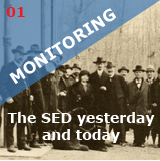
2014-01-07
Series of Aftershocks near Sargans
Since the earthquake with a magnitude of 4.1 between Sargans and Balzers (Liechtenstein) on December 12, 2013, the Swiss Seismological Service (SED) has localized 28 aftershocks in the region with magnitudes of between 3.6 and –0.2.
Read more...
The main tremor occurred on December 12, 2013, at 1.59 a.m. (local time) at a depth of seven kilometers. The SED received over 500 reports from people across German-speaking Switzerland, Liechtenstein, and Vorarlberg who had felt the tremor. There were also isolated reports from people in Western Switzerland. The aftershocks of December 16 and 27 with magnitudes of 2.3 and 3.6 as well as six further tremors, the last of which occurred on January 2, 2014, were similarly noticeable. These aftershocks were felt especially by residents near the epicenter in Sargans, Buchs (SG), Balzers, Maienfeld, and Mels. Tremors of this strength do not generally cause any damage. The strongest measured ground movements were 10 times lower than the values of the SIA norms for earthquake-resistant building design. In Switzerland, however, 90 percent of buildings have inadequate or unknown earthquake resistance.
Noticeable, larger earthquakes are nothing unusual in the region between Buchs and Sargans, yet occur relatively seldom. The seismic activity currently being observed in the region is a "normal" phenomenon within the scope of the expected aftershock activity following the tremor of December 12, 2013. Earthquakes cannot however currently be predicted or prevented. Tremors with a magnitude of around 6 occur in Switzerland once every 100 years on average and can in principle happen at any place and at any time.
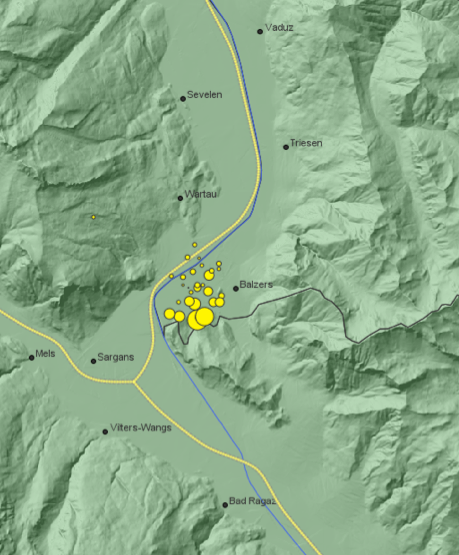
2013-12-28
Geothermal energy project in St. Gallen
The SED continues to monitor the geothermal borehole and the surrounding area with increased attention, and keeps the St. Gallen public utilities company and the public constantly informed about the seismic activity recorded through its website.
